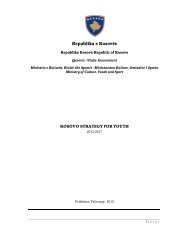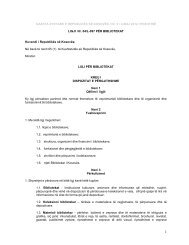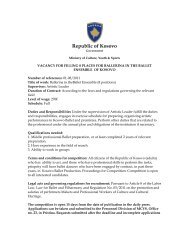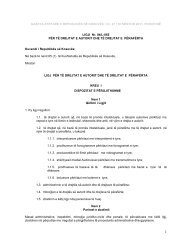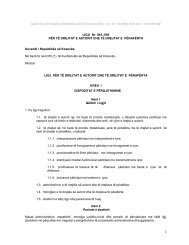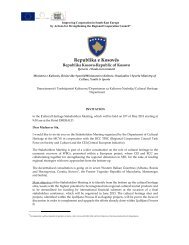Archaeological Guide of Kosovo
Archaeological Guide of Kosovo
Archaeological Guide of Kosovo
You also want an ePaper? Increase the reach of your titles
YUMPU automatically turns print PDFs into web optimized ePapers that Google loves.
espectively, social differentiation within the society, makes this period<br />
different and particular from earlier and later periods. The Bronze Age<br />
followed the Copper Age, stretching in the time period from 2500 up<br />
to 1100 BC. With the advancement <strong>of</strong> the metallurgy factorial industry,<br />
and with the mixing <strong>of</strong> copper with tin, the bronze was created as<br />
an alloy. The formula invention for creating this stronger metal, leads<br />
towards the preparation and production <strong>of</strong> weapons, tools and jewelry.<br />
The particularity <strong>of</strong> this period lies in the fact that matriarchate is replaced<br />
with patriarchate, the social differentiation was developed and<br />
the first elements <strong>of</strong> tribal aristocracy emerged. All new changes and<br />
developments are reflected in the material culture discovered in various<br />
sites across <strong>Kosovo</strong>. During the past researches’ carried in <strong>Kosovo</strong>, dozens<br />
<strong>of</strong> settlements, cemeteries and fortresses <strong>of</strong> the early, middle and late<br />
Bronze Age were recorded. Nevertheless, this period marks the beginning<br />
<strong>of</strong> the creation <strong>of</strong> the Illyrian ethnos which was consolidated during<br />
the following Iron Age (1100 BC-middle <strong>of</strong> the 4th Century BC.), a<br />
period that is credited for full consolidation <strong>of</strong> the ethno-culture unity<br />
<strong>of</strong> the Illyrians, respectively the Dardanians, as one <strong>of</strong> the biggest and<br />
the most populated tribes <strong>of</strong> vast territory, whereas, the present territory<br />
<strong>of</strong> the Republic <strong>of</strong> <strong>Kosovo</strong>, takes a central position within the Dardanian<br />
Kingdom. Besides the exploitation <strong>of</strong> the metals for the massive production<br />
<strong>of</strong> weapons and to some extent the working tools for agriculture,<br />
the Iron Age evidenced in <strong>Kosovo</strong> is well presented with lowland<br />
settlements but also with upland fortresses, <strong>of</strong>ten protected by traverses<br />
and ditches or drywalls. Regarding the fortifications, the Iron Age is<br />
characteristic for the erected fortresses on the top <strong>of</strong> the hills, with good<br />
geostrategic positions, partially protected by nature. Nevertheless, the<br />
identification ‘stamp’ <strong>of</strong> the Iron Age as documented, recorded and<br />
studied in <strong>Kosovo</strong>, are the burial mounds, or locally known as the tumulus<br />
graves (Illyrian grave hills), and quite dispersed all around <strong>Kosovo</strong>,<br />
counting maybe hundreds and either set in groups or even as solitary<br />
tumulus.<br />
34 <strong>Archaeological</strong> <strong>Guide</strong> <strong>of</strong> <strong>Kosovo</strong>




